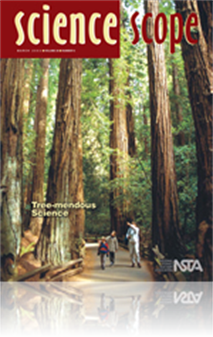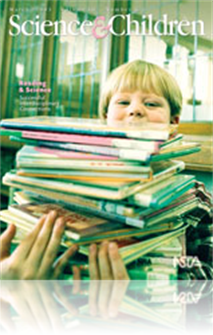All Resources
Journal Article
Tech Trek: Technologies for special needs students
You might wonder why today’s science teachers need to keep current with the latest technologies available for special education students. When you consider that more than 50 million Americans are identified as having a disability, classroom technol...
Journal Article
Design-Based Science: A problem-solving experiment compares different brands of batteries
Developing useful skills for a wide range of actual problem-solving situations involving science is one goal of design-based science. This article features a problem-solving experiment where students compare different brands of batteries to determine...
Journal Article
The three “legs” on which science instruction rests are the content of science, process of science, and the nature of science. Each leg performs its own function and need not be competitive with the others. This article uses the metaphor of a thr...
Journal Article
Tried and True: Whatever floats your boat
Ever since Archimedes ran down the streets of ancient Greece shouting, “Eureka!,” scientists have understood that a submerged body displaces a volume of water equal to its own volume. Scientists also came to realize that if a body weighed less t...
Journal Article
Research and Teaching: Attendance and Performance
Class attendance by most students in nonmajors science classes is influenced by whether they receive points for attending class. If students do not get points for attending class, there is a strong positive correlation of high class attendance with h...
Journal Article
Outstanding Science Trade Books for Students K-12: Books Published in 2002
These books were selected by members of a book review panel appointed by the National Science Teachers Association (NSTA) and assembled in cooperation with the Children’s Book Council (CBC). NSTA and CBC have cooperated on this bibliographic projec...
Journal Article
Outstanding Science Trade Books for Students K-12: Books published in 2002 (Science Scope)
The books that appear in this annotated bibliography were selected as outstanding science trade books published in 2002. They are intended primarily for kindergarten through twelfth grade. They were selected by members of a book review panel appointe...
Journal Article
Science Sampler: Anchor activities
What's the best way to keep students occupied when they have finished their work? An Anchor Activity Learning Station provides high-interest, educational options for students who have finished with required class assignments, labs, or investigations....
Journal Article
Libros de Ciencias en Español (2003)
If we are to encourage Spanish speakers to observe, identify, describe, experiment, and explain phenomena, we should offer them a wide selection of activities that lead them enthusiastically to the study of scientific concepts. From well designed bo...
Journal Article
Students expressed strong positive feelings about inquiry-based teaching methods the authors developed and implemented in an undergraduate exercise physiology laboratory course. Inquiry-based learning resulted in a higher order of learning not typica...
Journal Article
The authors developed an inquiry-based course that emphasizes integration of the sciences. Student teams pursue research projects of their own design using mathematics and physics to study biological phenomena. Faculty members from the mathematics, p...
Journal Article
Outstanding Science Trade Books for Students K-12: (Books Published in 2002)
This article contains a list of the outstanding science trade books published in 2002. It includes information about the selection process, committee, and the NSTA and CBC....
Journal Article
By spiraling and varying the curriculum, teachers can structure lessons with the appropriate activities for each student. Three lesson plans centered around the same experiment and the same big idea allow students to learn at their age-appropriate le...
Journal Article
The Ins and Outs of Guided Reading
A teacher and author of children’s books provides a model for incorporating guided reading strategies into the classroom. Includes extensions and cross-curricular activities along with suggestions of what to do before, during, and after reading....
Journal Article
The advancement of electric vehicle (EV) research is primarily due to increasing global concern over air pollution and greenhouse gases caused by vehicle emissions. This project gives students a deeper respect for the environment and a more incisive ...
Journal Article
Embed Assessment in Your Teaching
Broadly defined, embedded assessment using performance tasks requires students to write, read, and solve problems in genuine, rather than artificial ways. It is as an ongoing, cyclical process in which teachers gather information on their students’...
Journal Article
Science 101: How do plants make their own food?
Plants make their own food through a process called photosynthesis, a term that comes from the Greek language, meaning “arranging with light.” In this article, a botanist describes the fundamental concept of photosynthesis. ...
Journal Article
This activity focuses on Leonardo da Vinci's tree theory, which states that the cross-sectional area of a major limb is approximately equal to the cross-sectional areas of its two offshoot limbs. Students test this theory by collecting data from 10 t...
Journal Article
Undergraduate elementary education majors participate in an interdisciplinary course focused on modeling scientific systems. Students’ applications of three artificial intelligence concepts used in modeling scientific systems were investigated befo...
Journal Article
The Gender Gap in Science Education: Strategies to encourage female participation in science
Educational practices promoting female participation in science can be used to help lessen the persistent gender gap in secondary science classrooms. Educators must actively encourage young women's participation in science through constructive learni...
Journal Article
Motivating Students to Read Physics Content
Projects using trade books encourage students to learn various physics concepts and understand technical reading material. They can both reinforce and instruct science concepts and allow students a chance to acquire and process new information throug...







